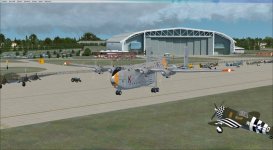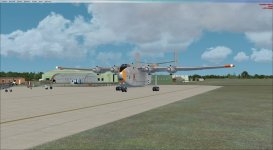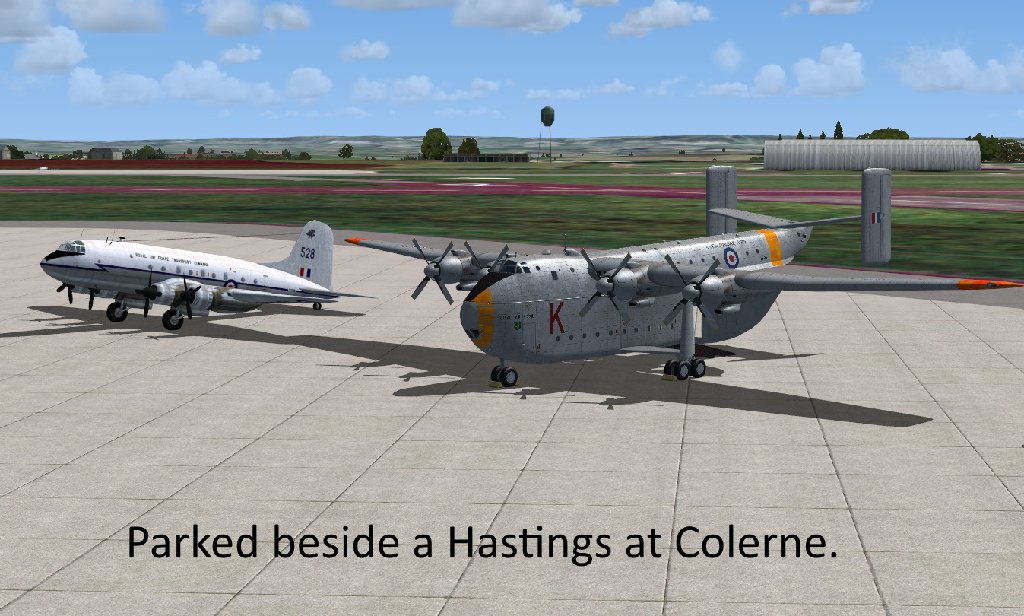nagpaw
SOH-CM-2022
Just a follow-up after some more flying. I departed Middle Wallop bound for Akrotiri with 5,000 pounds of freight and about 30 passengers with full tanks. All-up weight was about 132,000 pounds. Got off the 3,800 foot long Runway 17 with room to spare and easily cleared the trees south of the field. Climbed to 9,000 feet in about 10 minutes at 125 KIAS, using max continuous power ( about 50" and 2500 RPM). Settled into cruise using 38" and 2100 RPM burning about 470 gallons an hour.
For more about why I simulated these conditions, read about the Sutton Wick crash (https://en.wikipedia.org/wiki/Sutton_Wick_air_crash).
Long story short, the Beverley's pilot notes match all of that almost perfectly. With the cruise power setting I used, the book gives an indicated airspeed of approximately 135 knots. The FSX Beverley settled in at 137 knots indicated! My friends, I can't say enough about this model.
Disclaimer: I did make a change to the aircraft.cfg. The model as published had a total of 3,600 gallons of fuel (four tanks with 900 gals each). As near as I can tell, the Beverley had four fuel tanks in each wing (numbered 1 through 4) totaling 3,375 gallons, for a grand total of 6,750 gallons. So I changed the Mains to be equivalent to Tanks 1 and 2 (combined 2,145 gallons capacity each) and the Auxes to be equivalent to Tanks 3 and 4 (combined 1,230 gallons capacity each). Thankfully, the fuel gauges work in percentages and not gallons, so a quick change and everything works fine.
Hopefully with Manfred's and Wayne's blessing, here's what my [fuel] section looks like now...
LeftMain=-2, -14.0, 0, 2145, 12
LeftAux=-2, -31.0, 0, 1230, 12
RightMain=-2, 14.0, 0, 2145, 12
RightAux=-2, 31.0, 0, 1230, 12
If anyone is wondering, the Centaurus used Boost instead of Manifold Pressure for power settings. There's a formula to convert between the two, but the quick and dirty is (Boost x 2) + 30. That's how I came up with 38" for cruise. (Pilot notes say cruise is normally Boost +4...so (Boost 4 x 2)+30 = 8+30 = 38.
Manfred's modelling is exquisite as usual, and Wayne's flight model is as close to spot-on as I could imagine. Aces, guys!
For more about why I simulated these conditions, read about the Sutton Wick crash (https://en.wikipedia.org/wiki/Sutton_Wick_air_crash).
Long story short, the Beverley's pilot notes match all of that almost perfectly. With the cruise power setting I used, the book gives an indicated airspeed of approximately 135 knots. The FSX Beverley settled in at 137 knots indicated! My friends, I can't say enough about this model.
Disclaimer: I did make a change to the aircraft.cfg. The model as published had a total of 3,600 gallons of fuel (four tanks with 900 gals each). As near as I can tell, the Beverley had four fuel tanks in each wing (numbered 1 through 4) totaling 3,375 gallons, for a grand total of 6,750 gallons. So I changed the Mains to be equivalent to Tanks 1 and 2 (combined 2,145 gallons capacity each) and the Auxes to be equivalent to Tanks 3 and 4 (combined 1,230 gallons capacity each). Thankfully, the fuel gauges work in percentages and not gallons, so a quick change and everything works fine.
Hopefully with Manfred's and Wayne's blessing, here's what my [fuel] section looks like now...
LeftMain=-2, -14.0, 0, 2145, 12
LeftAux=-2, -31.0, 0, 1230, 12
RightMain=-2, 14.0, 0, 2145, 12
RightAux=-2, 31.0, 0, 1230, 12
If anyone is wondering, the Centaurus used Boost instead of Manifold Pressure for power settings. There's a formula to convert between the two, but the quick and dirty is (Boost x 2) + 30. That's how I came up with 38" for cruise. (Pilot notes say cruise is normally Boost +4...so (Boost 4 x 2)+30 = 8+30 = 38.
Manfred's modelling is exquisite as usual, and Wayne's flight model is as close to spot-on as I could imagine. Aces, guys!














 Hopefully someone finds all that useful!
Hopefully someone finds all that useful! 

